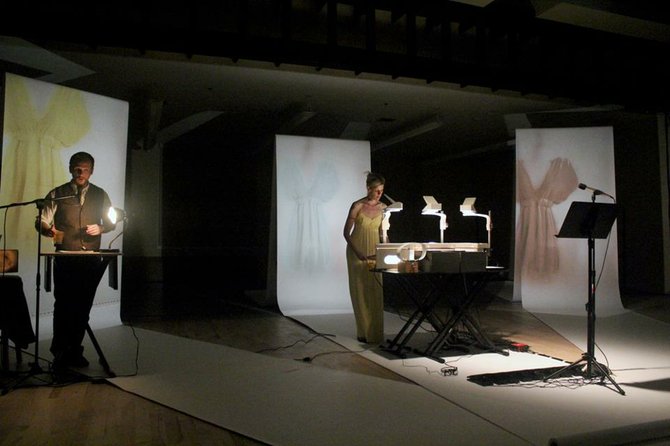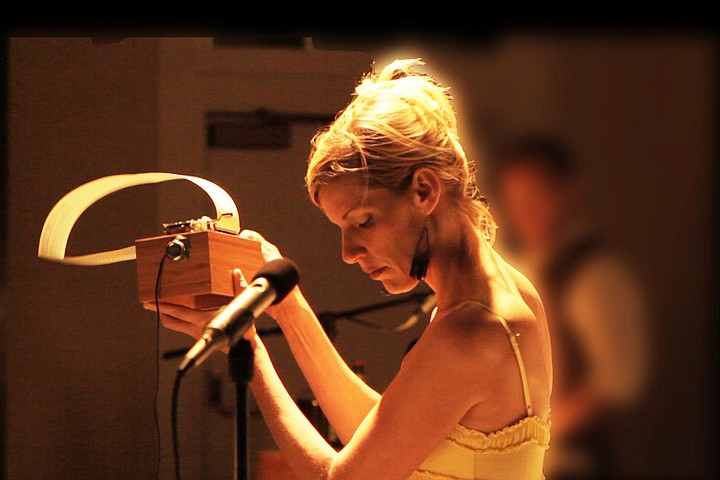 Facebook
Facebook
 X
X
 Instagram
Instagram
 TikTok
TikTok
 Youtube
Youtube

“The big worry,” says Margaret Noble, “is how much will you be like your parents and your grandparents...in ways you want, and don’t want.”
Her new production, *Righteous Exploits,* attempts to address that. It opens August 7th at the San Diego Museum of Art before getting a full run at Liberty Station’s White Box Theater from September 19th-22nd.
Without trying to reduce a Righteous Exploits to an unsatisfactory bullet point, the anxiety that we are all engaged in a process of becoming our parents, mostly by repeating their mistakes, is the unifying chord of Noble’s performance.
Noble knows that “performance art” is a loaded term for some people, and she’s justifiably careful with it. Not wanting to be confused with “the weird stuff that happened in the 1970’s...people throwing raw meat at feminists,” she draws a stronger connection between Righteous Exploits and conventional theatre, since the structure of the performance is ultimately centered around a generational narrative.

“[Righteous Exploits] is somewhere in the middle,” she says. “We’re using visual media, in particular three overhead projectors to represent the story visually. But there’s also real storytelling going on. I’m working with [So Say We All director] Justin Hudnall, who is an amazing storyteller.”
In terms of technique, Hudnall narrates the hour-long performance while Noble works the projectors and provides an ambient score, putting to work her MFA in sound art from the University of Chicago. Noble says that the overall effect is more cinematic than anything else, but with the immediacy of theatre instead of the remove of cinema.
Righteous Exploits began with Noble’s attempt to track down an antique set of stories, The Unvarnished Truth, told by the downtrodden and impoverished, and sold as entertainment. From there, she got drawn into the story of her own grandmother, a woman who campaigned for the rights of migrant workers, drawing the ire of the FBI and HUAC in paranoid, mid-century America. Finally, Noble ended up in introspection, realizing that the story she wanted to tell was her own.
“I think I picked up all the bad behavior of my ancestors, and now I’m trying to break it,” she says, with the candor that she feels gives Righteous Exploits its power.
Since the performance became autobiographical, Noble is putting her own bad behavior on display. There’s great vulnerability to judgment in that, but Noble thinks that using her personal narrative gives people a chance to open up, to turn their gazes inward and accept the unique sets of bad (and good) habits they’ve inherited from their parents and grandparents. Instead of a chance to sit in judgment of the artist, which may well happen anyways, there’s a chance for connection and acknowledgment of the universal appeal of the generational narrative.
Because of the personal nature of the show, Righteous Exploits is a pointed experience for Noble, something she hopes translates to viewers.
“It’s really for anybody interested in having an intense ride,” she says. Noble goes on to explain that she’s “rattling the cage” of her family connection, and that the experience was difficult for her and her mother, who nevertheless gave the show her blessing. “It was healthy to clear the air,” but the idea of questioning personal identity by prising open generational narratives and casting a critical eye towards the quasi-sacred space of family, and all the baggage that entails, is necessarily painful. She feels that uncovering the bad behaviors inherited from mom and grandma was ultimately restorative for her and her connection to her family.
Righteous Exploits hopes to be raw, confessional, and intimate. Its creator hopes to raise self-critical awareness of the repetitive nature of the generational narratives that seem to catch us all in patterns of repeating our parents' and grandparents' mistakes instead of learning from them. That should resonate with anyone who has ever been surprised by a momentary vision of his father's face in the mirror.


“The big worry,” says Margaret Noble, “is how much will you be like your parents and your grandparents...in ways you want, and don’t want.”
Her new production, *Righteous Exploits,* attempts to address that. It opens August 7th at the San Diego Museum of Art before getting a full run at Liberty Station’s White Box Theater from September 19th-22nd.
Without trying to reduce a Righteous Exploits to an unsatisfactory bullet point, the anxiety that we are all engaged in a process of becoming our parents, mostly by repeating their mistakes, is the unifying chord of Noble’s performance.
Noble knows that “performance art” is a loaded term for some people, and she’s justifiably careful with it. Not wanting to be confused with “the weird stuff that happened in the 1970’s...people throwing raw meat at feminists,” she draws a stronger connection between Righteous Exploits and conventional theatre, since the structure of the performance is ultimately centered around a generational narrative.

“[Righteous Exploits] is somewhere in the middle,” she says. “We’re using visual media, in particular three overhead projectors to represent the story visually. But there’s also real storytelling going on. I’m working with [So Say We All director] Justin Hudnall, who is an amazing storyteller.”
In terms of technique, Hudnall narrates the hour-long performance while Noble works the projectors and provides an ambient score, putting to work her MFA in sound art from the University of Chicago. Noble says that the overall effect is more cinematic than anything else, but with the immediacy of theatre instead of the remove of cinema.
Righteous Exploits began with Noble’s attempt to track down an antique set of stories, The Unvarnished Truth, told by the downtrodden and impoverished, and sold as entertainment. From there, she got drawn into the story of her own grandmother, a woman who campaigned for the rights of migrant workers, drawing the ire of the FBI and HUAC in paranoid, mid-century America. Finally, Noble ended up in introspection, realizing that the story she wanted to tell was her own.
“I think I picked up all the bad behavior of my ancestors, and now I’m trying to break it,” she says, with the candor that she feels gives Righteous Exploits its power.
Since the performance became autobiographical, Noble is putting her own bad behavior on display. There’s great vulnerability to judgment in that, but Noble thinks that using her personal narrative gives people a chance to open up, to turn their gazes inward and accept the unique sets of bad (and good) habits they’ve inherited from their parents and grandparents. Instead of a chance to sit in judgment of the artist, which may well happen anyways, there’s a chance for connection and acknowledgment of the universal appeal of the generational narrative.
Because of the personal nature of the show, Righteous Exploits is a pointed experience for Noble, something she hopes translates to viewers.
“It’s really for anybody interested in having an intense ride,” she says. Noble goes on to explain that she’s “rattling the cage” of her family connection, and that the experience was difficult for her and her mother, who nevertheless gave the show her blessing. “It was healthy to clear the air,” but the idea of questioning personal identity by prising open generational narratives and casting a critical eye towards the quasi-sacred space of family, and all the baggage that entails, is necessarily painful. She feels that uncovering the bad behaviors inherited from mom and grandma was ultimately restorative for her and her connection to her family.
Righteous Exploits hopes to be raw, confessional, and intimate. Its creator hopes to raise self-critical awareness of the repetitive nature of the generational narratives that seem to catch us all in patterns of repeating our parents' and grandparents' mistakes instead of learning from them. That should resonate with anyone who has ever been surprised by a momentary vision of his father's face in the mirror.
Comments